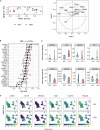Treated HIV Infection Alters Phenotype but Not HIV-Specific Function of Peripheral Blood Natural Killer Cells
- PMID: 32477342
- PMCID: PMC7235409
- DOI: 10.3389/fimmu.2020.00829
Treated HIV Infection Alters Phenotype but Not HIV-Specific Function of Peripheral Blood Natural Killer Cells
Abstract
Natural killer (NK) cells are the predominant antiviral cells of the innate immune system, and may play an important role in acquisition and disease progression of HIV. While untreated HIV infection is associated with distinct alterations in the peripheral blood NK cell repertoire, less is known about how NK phenotype is altered in the setting of long-term viral suppression with antiretroviral therapy (ART), as well as how NK memory can impact functional responses. As such, we sought to identify changes in NK cell phenotype and function using high-dimensional mass cytometry to simultaneously analyze both surface and functional marker expression of peripheral blood NK cells in a cohort of ART-suppressed, HIV+ patients and HIV- healthy controls. We found that the NK cell repertoire following IL-2 treatment was altered in individuals with treated HIV infection compared to healthy controls, with increased expression of markers including NKG2C and CD2, and decreased expression of CD244 and NKp30. Using co-culture assays with autologous, in vitro HIV-infected CD4 T cells, we identified a subset of NK cells with enhanced responsiveness to HIV-1-infected cells, but no differences in the magnitude of anti-HIV NK cell responses between the HIV+ and HIV- groups. In addition, by profiling of NK cell receptors on responding cells, we found similar phenotypes of HIV-responsive NK cell subsets in both groups. Lastly, we identified clusters of NK cells that are altered in individuals with treated HIV infection compared to healthy controls, but found that these clusters are distinct from those that respond to HIV in vitro. As such, we conclude that while chronic, treated HIV infection induces a reshaping of the IL-2-stimulated peripheral blood NK cell repertoire, it does so in a way that does not make the repertoire more HIV-specific.
Keywords: CyTOF; HIV-1; NK cells; innate immunity; memory.
Copyright © 2020 Zhao, Ferreira, Grant, Holmes and Blish.
Figures




Similar articles
-
Normalization of natural killer cell function and phenotype with effective anti-HIV therapy and the role of IL-10.AIDS. 2002 Jun 14;16(9):1251-6. doi: 10.1097/00002030-200206140-00007. AIDS. 2002. PMID: 12045490 Clinical Trial.
-
Increased Natural Killer Cell Activation in HIV-Infected Immunologic Non-Responders Correlates with CD4+ T Cell Recovery after Antiretroviral Therapy and Viral Suppression.PLoS One. 2017 Jan 11;12(1):e0167640. doi: 10.1371/journal.pone.0167640. eCollection 2017. PLoS One. 2017. PMID: 28076376 Free PMC article. Clinical Trial.
-
Interleukin-15-Stimulated Natural Killer Cells Clear HIV-1-Infected Cells following Latency Reversal Ex Vivo.J Virol. 2018 May 29;92(12):e00235-18. doi: 10.1128/JVI.00235-18. Print 2018 Jun 15. J Virol. 2018. PMID: 29593039 Free PMC article.
-
Effects of HIV infection and ART on phenotype and function of circulating monocytes, natural killer, and innate lymphoid cells.AIDS Res Ther. 2018 Mar 15;15(1):7. doi: 10.1186/s12981-018-0194-y. AIDS Res Ther. 2018. PMID: 29544508 Free PMC article. Review.
-
Natural killer cells in HIV-1 infection and therapy.AIDS. 2017 Nov 13;31(17):2317-2330. doi: 10.1097/QAD.0000000000001645. AIDS. 2017. PMID: 28926399 Free PMC article. Review.
Cited by
-
Low pre-ART CD4 count is associated with increased risk of clinical progression or death even after reaching 500 CD4 cells/μL on ART.PLoS One. 2023 Mar 30;18(3):e0283648. doi: 10.1371/journal.pone.0283648. eCollection 2023. PLoS One. 2023. PMID: 36996018 Free PMC article.
-
Natural killer cell phenotype is altered in HIV-exposed seronegative women.PLoS One. 2020 Sep 1;15(9):e0238347. doi: 10.1371/journal.pone.0238347. eCollection 2020. PLoS One. 2020. PMID: 32870938 Free PMC article.
-
Analyzing high-dimensional cytometry data using FlowSOM.Nat Protoc. 2021 Aug;16(8):3775-3801. doi: 10.1038/s41596-021-00550-0. Epub 2021 Jun 25. Nat Protoc. 2021. PMID: 34172973 Review.
-
Progress and applications of mass cytometry in sketching immune landscapes.Clin Transl Med. 2020 Oct;10(6):e206. doi: 10.1002/ctm2.206. Clin Transl Med. 2020. PMID: 33135337 Free PMC article. Review.
-
Harnessing Natural Killer Cell Innate and Adaptive Traits in HIV Infection.Front Cell Infect Microbiol. 2020 Aug 4;10:395. doi: 10.3389/fcimb.2020.00395. eCollection 2020. Front Cell Infect Microbiol. 2020. PMID: 32850493 Free PMC article. Review.
References
-
- Brunetta E, Fogli M, Varchetta S, Bozzo L, Hudspeth KL, Marcenaro E, et al. The decreased expression of Siglec-7 represents an early marker of dysfunctional natural killer–cell subsets associated with high levels of HIV-1 viremia. Blood. (2009) 114:3822–30. 10.1182/blood-2009-06-226332 - DOI - PMC - PubMed
Publication types
MeSH terms
Substances
Grants and funding
LinkOut - more resources
Full Text Sources
Other Literature Sources
Medical
Research Materials

